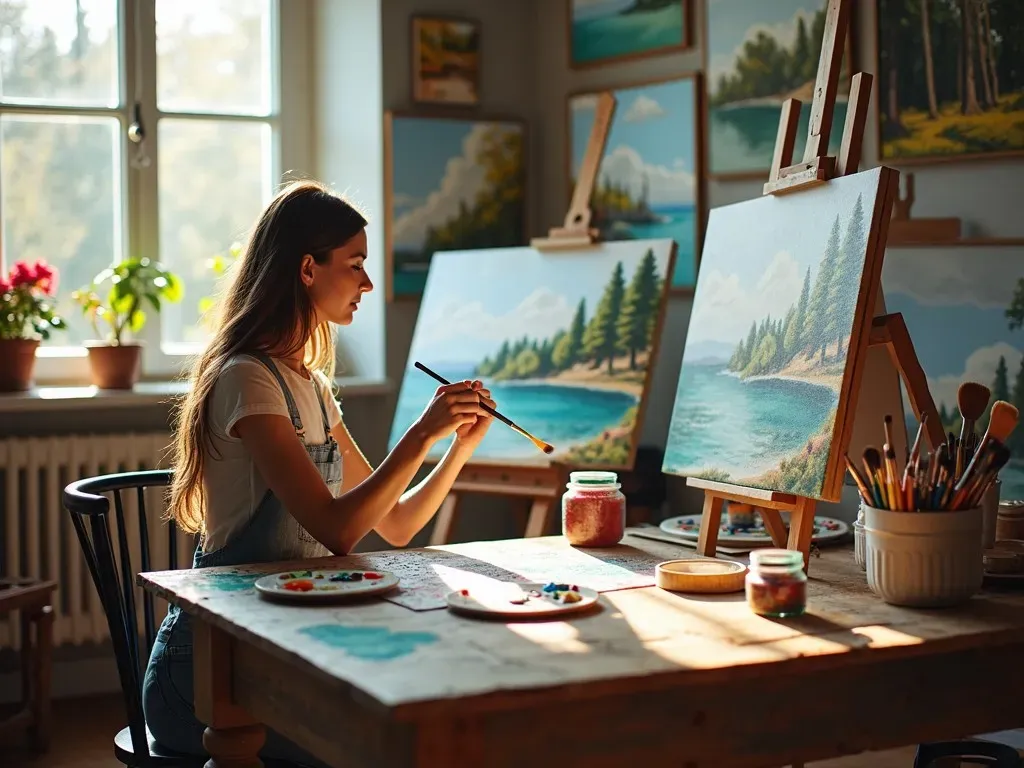The term "oil painting pics" refers to a captivating array of images created using oil paint on canvas or other media. Oil painting is one of the oldest and most valued forms of artistic expression, known for its vibrant colors and ability to capture fine details. This article delves into the world of oil painting images, exploring their significance, the Techniques involved, and how to effectively use these images in various contexts.
The Allure of Oil Paintings
Oil painting is characterized by its rich textures and brilliant colors, achieved through the blending of pigments with oil as a binder. The flexibility of oil paints allows artists to create a wide range of effects, from the delicate nuances of a portrait to the dramatic boldness of abstract art.
Benefits of Oil Painting
- Color Depth: Oil paintings often feature unparalleled depth and vibrancy due to the natural gloss of oil paints.
- Versatility: Artists can manipulate and layer oil paints over extended periods, enabling unique techniques such as glazing and impasto.
- Durability: Once dried, oil paintings are highly durable and can last for centuries, making them ideal for high-value art pieces.
Popular Subjects in Oil Painting Pics
Here are some common themes that can be seen in oil art:
- Landscapes: Capturing the beauty of nature, from serene countryside vistas to dramatic seascapes.
- Portraits: Depicting the human form, emotions, and personality.
- Still Life: Arrangements of objects, commonly used to practice lighting and composition.
- Abstract: Focused on colors and forms rather than recognizable subjects.
Techniques Used in Oil Painting
The approaches to oil painting can dramatically influence the final piece. Here are some popular techniques:
- Glazing: Applying thin layers of translucent color over dry paint to create depth.
- Impasto: Applying thick layers of paint to add texture.
- Grisaille: A style that uses shades of gray to imitate sculpture.
- Underpainting: Laying down a monochrome base layer on which the final colors are applied.
| Technique | Description |
|---|---|
| Glazing | Transparent layers for depth and luminescence |
| Impasto | Thick paint application for a three-dimensional effect |
| Grisaille | Monochromatic underpainting to define shapes |
| Underpainting | Base layer to establish values before applying color |
How to Source Quality Oil Painting Pics
In today’s digital age, discovering high-quality oil painting pictures is easier than ever. Here are some recommended resources:
- Unsplash: Offers over 750 free oil painting images suitable for commercial use. Visit Unsplash
- Pixabay: Houses an expansive collection of over 53,975 free oil painting images. Explore Pixabay
- Getty Images: A vast repository of high-resolution oil painting images, featuring both classical and contemporary works. Browse Getty Images
Incorporating Oil Painting Images in Projects
Oil painting images can enhance various projects, including:
- Decorating Interiors: Original or printed oil paintings can elevate the aesthetic of any room.
- Content Creation: Use images for blog posts, articles, or educational content related to art.
- Marketing Materials: Enhance flyers, brochures, or business cards with artistic visuals.
Famous Oil Paintings and Their Artists
A selection of renowned oil paintings that have made a significant impact on the art world includes:
| Painting | Artist | Year |
|---|---|---|
| Mona Lisa | Leonardo da Vinci | 1503-1506 |
| The Starry Night | Vincent van Gogh | 1889 |
| Girl with a Pearl Earring | Johannes Vermeer | 1665 |
| The Persistence of Memory | Salvador Dalí | 1931 |
These masterpieces are not only artistic achievements but also cultural landmarks that continue to inspire artists and art lovers alike.
Frequently Asked Questions (FAQ)
What is the best way to preserve oil paintings?
To ensure the longevity of oil paintings, keep them in a cool, dry place, away from direct sunlight. Use an archival-quality varnish to protect the surface.
How do I differentiate between original oil paintings and reproductions?
Original oil paintings are created by the artist using oil paints, while reproductions are prints or copies of original artworks. Original pieces may have unique textures and brushwork that prints lack.
Can I use oil painting pics for commercial projects?
It depends on the source. Always check the usage rights on images. Free-to-use platforms like Unsplash and Pixabay often allow commercial use if specified.
Are there any online communities for oil painting enthusiasts?
Yes, platforms like DeviantArt and ArtStation feature communities where artists can share their oil paintings, connect, and receive feedback.
Where can I learn oil painting techniques?
Numerous online platforms offer courses and tutorials for aspiring oil painters, including Skillshare, Udemy, and YouTube channels focused on art education.
Oil painting is more than a technique; it’s an enduring form of expression that resonates with artists and viewers alike. By harnessing the beauty of "oil painting pics," you can explore this vibrant art form’s potential in various applications. With countless resources available at your fingertips, the journey into the world of oil painting can begin today.
